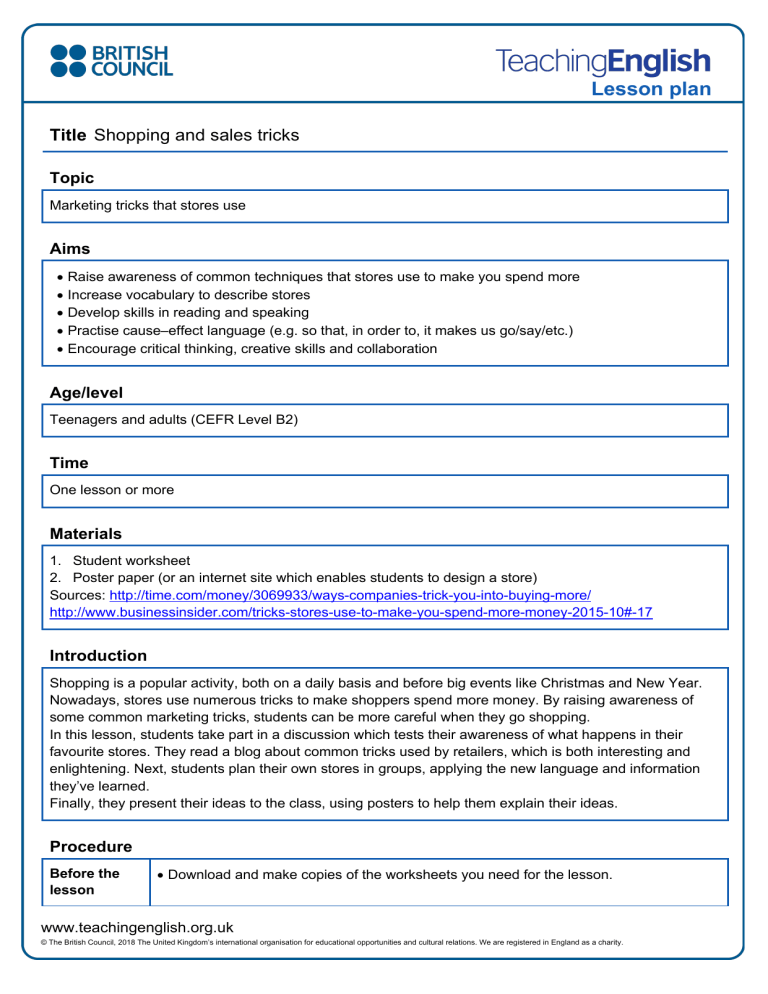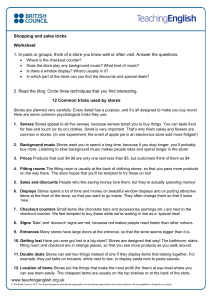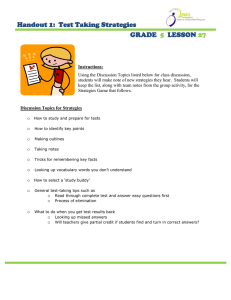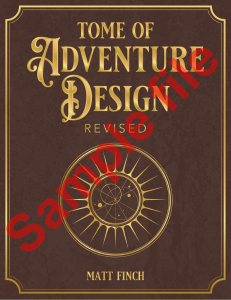
Lesson plan Title Shopping and sales tricks Topic Marketing tricks that stores use Aims • • • • • Raise awareness of common techniques that stores use to make you spend more Increase vocabulary to describe stores Develop skills in reading and speaking Practise cause–effect language (e.g. so that, in order to, it makes us go/say/etc.) Encourage critical thinking, creative skills and collaboration Age/level Teenagers and adults (CEFR Level B2) Time One lesson or more Materials 1. Student worksheet 2. Poster paper (or an internet site which enables students to design a store) Sources: http://time.com/money/3069933/ways-companies-trick-you-into-buying-more/ http://www.businessinsider.com/tricks-stores-use-to-make-you-spend-more-money-2015-10#-17 Introduction Shopping is a popular activity, both on a daily basis and before big events like Christmas and New Year. Nowadays, stores use numerous tricks to make shoppers spend more money. By raising awareness of some common marketing tricks, students can be more careful when they go shopping. In this lesson, students take part in a discussion which tests their awareness of what happens in their favourite stores. They read a blog about common tricks used by retailers, which is both interesting and enlightening. Next, students plan their own stores in groups, applying the new language and information they’ve learned. Finally, they present their ideas to the class, using posters to help them explain their ideas. Procedure Before the lesson • Download and make copies of the worksheets you need for the lesson. www.teachingenglish.org.uk © The British Council, 2018 The United Kingdom’s international organisation for educational opportunities and cultural relations. We are registered in England as a charity. Lesson plan 1. Warm-up (10 mins) • If appropriate, ask students how many days there are until Christmas (or another time when people buy gifts). Explain that today’s lesson is to learn about techniques that stores use to make you spend more money. • Divide students into pairs or groups. Hand out the worksheet. • Students discuss the questions in Q1. Provide help with the following vocabulary: checkout counter, window display, background music, discounts, special deals. 2. Reading (20 mins) • Students read the blog individually and silently. Set a time limit of 10 minutes. • They read and circle three techniques that they find interesting. After reading, students compare what they circled. • (Optional) Draw students’ attention to the language of cause–effect, for example so that you …, so you …, in order to …, it makes you … Ask students to find examples. • Put students into pairs or groups. Explain that they should discuss the different types of techniques, give examples, and state the effect they have on us as shoppers. Point out that there is more than one answer for some. • Students answer the questions in pairs or groups. Monitor and help if necessary. AK (possible answers): 1. Techniques about location/layout: 4, 7, 10, 11, 12 Some (like putting the fitting rooms at the back) make you move from one place to another so that you see more products. Others (like the window display) tempt people who are passing by to go into the store. Others (like putting things at eye level) are done so that you see the items that make the most profit for the store. Others sell more products (such as the double deal and the items at the checkout counter). 2. Tricks of the senses: 1, 2, 6, 8 Some (like tasting and touching products) make you feel more interest in the items. Others (like attractive smells and sights) draw you to a certain part of the store/shelf so that you see what’s there. Others (like listening) make you shop more slowly so that you buy more. 3. Tricks of the mind: 2, 3, 5, 6, 8, 9 Sale and discount signs are red so that you react more quickly. Some tricks are about money (like using .99 in prices) so that you think it’s cheaper than it is. Stores often change the window display so that we think there is something new. 3. Project • Explain that students are going to design their own store now. In pairs or groups, they can design a store that sells food or clothes. • First, encourage students to think clearly about what kind of store they want to plan and what they will sell in it. Then, follow the steps on the worksheet. • Students can use a design app on the internet or their own ideas on a poster. They can complete this for homework (or next lesson). Finally, students show their stores to each other and explain why they have done certain things (for example, ‘We put the fitting rooms at the back so that customers pass this counter.’). Contributed by Kate Cory-Wright www.teachingenglish.org.uk © The British Council, 2018 The United Kingdom’s international organisation for educational opportunities and cultural relations. We are registered in England as a charity.



